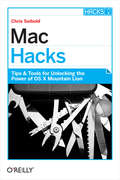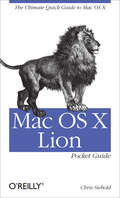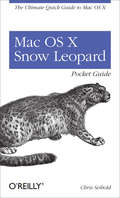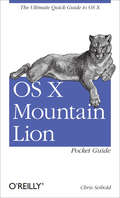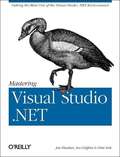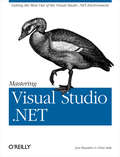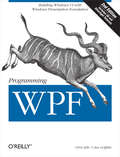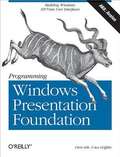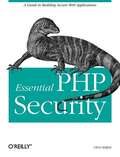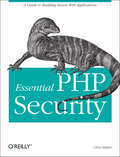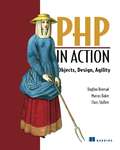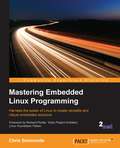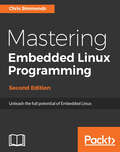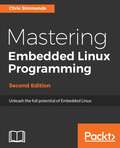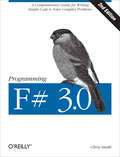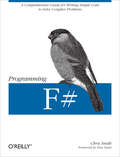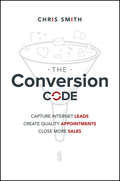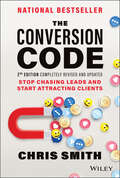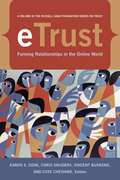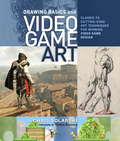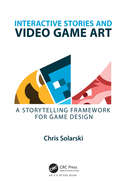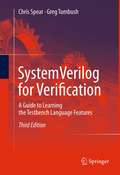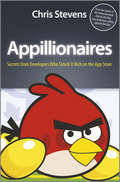- Table View
- List View
Mac Hacks: Tips & Tools for unlocking the power of OS X
by Chris SeiboldWant to take real control of your Mac? The hacks in this book help you dig below the surface to tweak system preferences, mount drives and devices, and generally do things with your system that Apple doesn’t expect you to do. With a little effort, you can make your Mac and its applications perform exactly the way you want them to.There are more than 50 hacks in this book that show you how to fine-tune the interface, work with multimedia, set up your network, boost security, and perform a few tricks with Unix.Go beyond Preferences: change the way OS X Mountain Lion behavesCustomize your experience by taming browsers and making apps full screenGet information delivered right to your desktop, and automate mundane tasksUse the command line and install various Unix apps to unlock your Mac’s Unix powerIncrease security, monitor network traffic, and remain anonymousPlay Wii games and host a Minecraft server on your MacModify your WiFi, move iTunes, and record TV showsTurn your MacBook into a tablet and give it a custom dye job
Mac OS X Lion Pocket Guide: The Ultimate Quick Guide to Mac OS X
by Chris SeiboldWith the addition of features and multi-touch gestures first pioneered on the iPhone and iPad, Lion is truly different than any other Mac OS. This handy guide is packed with concise information to help you quickly get started with Lion, whether you're new to the Mac or a longtime user. Once you learn the essentials, you can use this book as a resource for problem-solving on the fly. Mac OS X Lion Pocket Guide goes right to the heart of Lion, with details on system preferences, built-in applications, and utilities. You'll find configuration tips, keyboard shortcuts, guides for troubleshooting, lots of step-by-step instructions, and many other features--all in an easy-to-read format. Learn what's new, including Lion's iOS-inspired features Get quick tips for configuring and customizing your Mac Solve problems with a quick guide to the fundamentals like the Finder and Dock Use keyboard shortcuts to work more efficiently Take advantage of Lion's built-in applications and utilities Manage user accounts and passwords
Mac OS X Snow Leopard Pocket Guide: The Ultimate Quick Guide to Mac OS X (Pocket ref / guide)
by Chris SeiboldWhether you're new to the Mac or a longtime user, this handy book is the quickest way to get up to speed on Snow Leopard. Packed with concise information in an easy-to-read format, Mac OS X Snow Leopard Pocket Guide covers what you need to know and is an ideal resource for problem-solving on the fly. This book goes right to the heart of Snow Leopard, with details on system preferences, built-in applications, and utilities. You'll also find configuration tips, keyboard shortcuts, guides for troubleshooting, lots of step-by-step instructions, and more.Learn about new features and changes since the original Leopard releaseGet quick tips for setting up and customizing your Mac's configurationSolve problems with the handy reference to the fundamentals of the Finder, Dock, and moreUnderstand how to manage user accountsWork more efficiently using keyboard shortcutsTake advantage of MobileMe, Apple's online suite of services and tools
OS X Mountain Lion Pocket Guide
by Chris SeiboldGet the concise information you need to start using OS X Mountain Lion, the latest version of the Mac operating system. This handy guide goes right to the heart of the OS, with details on system preferences, built-in applications, utilities, and other features. Once you're familiar with the fundamentals, use this book as a resource for problem-solving on the fly. You get configuration tips, lots of step-by-step instructions, guides for troubleshooting, and other advice--all in an easy-to-read format. Learn what's new, including improved iCloud integration and other iPad-inspired features Discover how working with multiple devices is easier and more streamlined with Mountain Lion Get a guide to the Finder, Dock, user accounts, and other essentials Use Mountain Lion's system preferences to customize your Mac Take advantage of OS X applications, such as FaceTime and Time Machine Manage passwords and secure your data Work more efficiently with a complete list of keyboard shortcuts
Mastering Visual Studio .NET
by Jon Flanders Chris SellsMastering Visual Studio .NETprovides you, as an experienced programmer, with all the information needed to get the most out of the latest and greatest development tool from Microsoft®. Written by experienced developers and trainers John Flanders, Ian Griffiths, and Chris Sells, this book not only covers the fundamentals, but also shows how to customize and extend the toolkit to your specific needs.
Mastering Visual Studio .NET: Getting the Most Out of the Visual Studio .NET Environment (O'reilly Ser.)
by Jon Flanders Chris Sells Ian Griffiths<p><i>Mastering Visual Studio .NET</i> provides you, as an experienced programmer, with all the information needed to get the most out of the latest and greatest development tool from Microsoft®. Written by experienced developers and trainers John Flanders, Ian Griffiths, and Chris Sells, this book not only covers the fundamentals, but also shows how to customize and extend the toolkit to your specific needs.</p>
Programming WPF, 2nd Edition
by Chris Sells Ian GriffithsIf you want to build applications that take full advantage of Windows Vista's new user interface capabilities, you need to learn Microsoft's Windows Presentation Foundation (WPF). This new edition, fully updated for the official release of .NET 3.0, is designed to get you up to speed on this technology quickly. By page 2, you'll be writing a simple WPF application. By the end of Chapter 1, you'll have taken a complete tour of WPF and its major elements.WPF is the new presentation framework for Windows Vista that also works with Windows XP. It's a cornucopia of new technologies, which includes a new graphics engine that supports 3-D graphics, animation, and more; an XML-based markup language, called XAML, for declaring the structure of your Windows UI; and a radical new model for controls.This second edition includes new chapters on printing, XPS, 3-D, navigation, text and documents, along with a new appendix that covers Microsoft's new WPF/E platform for delivering richer UI through standard web browsers -- much like Adobe Flash. Content from the first edition has been significantly expanded and modified. Programming WPF includes:Scores of C# and XAML examples that show you what it takes to get a WPF application up and running, from a simple "Hello, Avalon" program to a tic-tac-toe gameInsightful discussions of the powerful new programming styles that WPF brings to Windows development, especially its new model for controlsA color insert to better illustrate WPF support for 3-D, color, and other graphics effectsA tutorial on XAML, the new HTML-like markup language for declaring Windows UIAn explanation and comparison of the features that support interoperability with Windows Forms and other Windows legacy applicationsWPF represents the best of the control-based Windows world and the content-based web world. Programming WPF helps you bring it all together.
Programming WPF: Building Windows UI with Windows Presentation Foundation
by Chris Sells Ian GriffithsIf you want to build applications that take full advantage of Windows Vista's new user interface capabilities, you need to learn Microsoft's Windows Presentation Foundation (WPF). This new edition, fully updated for the official release of .NET 3.0, is designed to get you up to speed on this technology quickly. By page 2, you'll be writing a simple WPF application. By the end of Chapter 1, you'll have taken a complete tour of WPF and its major elements. WPF is the new presentation framework for Windows Vista that also works with Windows XP. It's a cornucopia of new technologies, which includes a new graphics engine that supports 3-D graphics, animation, and more; an XML-based markup language, called XAML, for declaring the structure of your Windows UI; and a radical new model for controls. This second edition includes new chapters on printing, XPS, 3-D, navigation, text and documents, along with a new appendix that covers Microsoft's new WPF/E platform for delivering richer UI through standard web browsers -- much like Adobe Flash. Content from the first edition has been significantly expanded and modified. Programming WPF includes: Scores of C# and XAML examples that show you what it takes to get a WPF application up and running, from a simple "Hello, Avalon" program to a tic-tac-toe gameInsightful discussions of the powerful new programming styles that WPF brings to Windows development, especially its new model for controlsA color insert to better illustrate WPF support for 3-D, color, and other graphics effectsA tutorial on XAML, the new HTML-like markup language for declaring Windows UIAn explanation and comparison of the features that support interoperability with Windows Forms and other Windows legacy applications WPF represents the best of the control-based Windows world and the content-based web world. Programming WPF helps you bring it all together.
Programming Windows Presentation Foundation
by Chris Sells Ian GriffithsWindows Presentation Foundation (WPF) (formerly known by its code name "Avalon") is a brand-new presentation framework for Windows XP and Windows Vista, the next version of the Windows client operating system. For developers, WPF is a cornucopia of new technologies, including a new graphics engine that supports 3-D graphics, animation, and more; an XML-based markup language (XAML) for declaring the structure of your Windows UI; and a radical new model for controls. Programming Windows Presentation Foundation is the book you need to get up to speed on WPF. By page two, you'll have written your first WPF application, and by the end of Chapter 1, "Hello WPF," you'll have completed a rapid tour of the framework and its major elements. These include the XAML markup language and the mapping of XAML markup to WinFX code; the WPF content model; layout; controls, styles, and templates; graphics and animation; and, finally, deployment. Programming Windows Presentation Foundation features: Scores of C# and XAML examples that show you what it takes to get a WPF application up and running, from a simple "Hello, Avalon" program to a tic-tac-toe game Insightful discussions of the powerful new programming styles that WPF brings to Windows development, especially its new model for controls A color insert to better illustrate WPF support for 3-D, color, and other graphics effects A tutorial on XAML, the new HTML-like markup language for declaring Windows UI An explanation and comparison of the features that support interoperability with Windows Forms and other Windows legacy applications The next generation of Windows applications is going to blaze a trail into the unknown. WPF represents the best of the control-based Windows world and the content-based web world; it's an engine just itching to be taken for a spin. Inside, you'll find the keys to the ignition.
Essential PHP Security
by Chris ShiflettBeing highly flexible in building dynamic, database-driven web applications makes the PHP programming language one of the most popular web development tools in use today. It also works beautifully with other open source tools, such as the MySQL database and the Apache web server. However, as more web sites are developed in PHP, they become targets for malicious attackers, and developers need to prepare for the attacks. Security is an issue that demands attention, given the growing frequency of attacks on web sites. Essential PHP Security explains the most common types of attacks and how to write code that isn't susceptible to them. By examining specific attacks and the techniques used to protect against them, you will have a deeper understanding and appreciation of the safeguards you are about to learn in this book. In the much-needed (and highly-requested) Essential PHP Security , each chapter covers an aspect of a web application (such as form processing, database programming, session management, and authentication). Chapters describe potential attacks with examples and then explain techniques to help you prevent those attacks. Topics covered include: Preventing cross-site scripting (XSS) vulnerabilities Protecting against SQL injection attacks Complicating session hijacking attempts You are in good hands with author Chris Shiflett, an internationally-recognized expert in the field of PHP security. Shiflett is also the founder and President of Brain Bulb, a PHP consultancy that offers a variety of services to clients around the world.
Essential PHP Security: A Guide to Building Secure Web Applications
by Chris ShiflettBeing highly flexible in building dynamic, database-driven web applications makes the PHP programming language one of the most popular web development tools in use today. It also works beautifully with other open source tools, such as the MySQL database and the Apache web server. However, as more web sites are developed in PHP, they become targets for malicious attackers, and developers need to prepare for the attacks.Security is an issue that demands attention, given the growing frequency of attacks on web sites. Essential PHP Security explains the most common types of attacks and how to write code that isn't susceptible to them. By examining specific attacks and the techniques used to protect against them, you will have a deeper understanding and appreciation of the safeguards you are about to learn in this book.In the much-needed (and highly-requested) Essential PHP Security, each chapter covers an aspect of a web application (such as form processing, database programming, session management, and authentication). Chapters describe potential attacks with examples and then explain techniques to help you prevent those attacks.Topics covered include:Preventing cross-site scripting (XSS) vulnerabilitiesProtecting against SQL injection attacksComplicating session hijacking attemptsYou are in good hands with author Chris Shiflett, an internationally-recognized expert in the field of PHP security. Shiflett is also the founder and President of Brain Bulb, a PHP consultancy that offers a variety of services to clients around the world.
PHP in Action: Objects, Design, Agility
by Chris Shiflett Marcus Baker Dagfinn ReiersolTo keep programming productive and enjoyable, state-of-the-art practices andprinciples are essential. Object-oriented programming and design help managecomplexity by keeping components cleanly separated. Unit testing helps preventendless, exhausting debugging sessions. Refactoring keeps code supple andreadable. PHP offers all this-and more.PHP in Action shows you how to apply PHP techniques and principles to all themost common challenges of web programming, including:Web presentation and templatesUser interaction including the Model-View-Contoller architectureInput validation and form handlingDatabase connection and querying and abstractionObject persistence Purchase of the print book comes with an offer of a free PDF, ePub, and Kindle eBook from Manning. Also available is all code from the book.
Mastering Embedded Linux Programming
by Chris SimmondsHarness the power of Linux to create versatile and robust embedded solutions About This Book * Create efficient and secure embedded devices using Linux * Minimize project costs by using open source tools and programs * Explore each component technology in depth, using sample implementations as a guide Who This Book Is For This book is ideal for Linux developers and system programmers who are already familiar with embedded systems and who want to know how to create best-in-class devices. A basic understanding of C programming and experience with systems programming is needed. What You Will Learn * Understand the role of the Linux kernel and select an appropriate role for your application * Use Buildroot and Yocto to create embedded Linux systems quickly and efficiently * Create customized bootloaders using U-Boot * Employ perf and ftrace to identify performance bottlenecks * Understand device trees and make changes to accommodate new hardware on your device * Write applications that interact with Linux device drivers * Design and write multi-threaded applications using POSIX threads * Measure real-time latencies and tune the Linux kernel to minimize them In Detail Mastering Embedded Linux Programming takes you through the product cycle and gives you an in-depth description of the components and options that are available at each stage. You will begin by learning about toolchains, bootloaders, the Linux kernel, and how to configure a root filesystem to create a basic working device. You will then learn how to use the two most commonly used build systems, Buildroot and Yocto, to speed up and simplify the development process. Building on this solid base, the next section considers how to make best use of raw NAND/NOR flash memory and managed flash eMMC chips, including mechanisms for increasing the lifetime of the devices and to perform reliable in-field updates. Next, you need to consider what techniques are best suited to writing applications for your device. We will then see how functions are split between processes and the usage of POSIX threads, which have a big impact on the responsiveness and performance of the final device The closing sections look at the techniques available to developers for profiling and tracing applications and kernel code using perf and ftrace. Style and approach This book is an easy-to-follow and pragmatic guide consisting of an in-depth analysis of the implementation of embedded devices. Each topic has a logical approach to it; this coupled with hints and best practices helps you understand embedded Linux better.
Mastering Embedded Linux Programming - Second Edition
by Chris SimmondsMaster the techniques needed to build great, efficient embedded devices on Linux About This Book • Discover how to build and configure reliable embedded Linux devices • This book has been updated to include Linux 4.9 and Yocto Project 2.2 (Morty) • This comprehensive guide covers the remote update of devices in the field and power management Who This Book Is For If you are an engineer who wishes to understand and use Linux in embedded devices, this book is for you. It is also for Linux developers and system programmers who are familiar with embedded systems and want to learn and program the best in class devices. It is appropriate for students studying embedded techniques, for developers implementing embedded Linux devices, and engineers supporting existing Linux devices. What You Will Learn • Evaluate the Board Support Packages offered by most manufacturers of a system on chip or embedded module • Use Buildroot and the Yocto Project to create embedded Linux systems quickly and efficiently • Update IoT devices in the field without compromising security • Reduce the power budget of devices to make batteries last longer • Interact with the hardware without having to write kernel device drivers • Debug devices remotely using GDB, and see how to measure the performance of the systems using powerful tools such as perk, ftrace, and valgrind • Find out how to configure Linux as a real-time operating system In Detail Embedded Linux runs many of the devices we use every day, from smart TVs to WiFi routers, test equipment to industrial controllers - all of them have Linux at their heart. Linux is a core technology in the implementation of the inter-connected world of the Internet of Things. The comprehensive guide shows you the technologies and techniques required to build Linux into embedded systems. You will begin by learning about the fundamental elements that underpin all embedded Linux projects: the toolchain, the bootloader, the kernel, and the root filesystem. You'll see how to create each of these elements from scratch, and how to automate the process using Buildroot and the Yocto Project. Moving on, you'll find out how to implement an effective storage strategy for flash memory chips, and how to install updates to the device remotely once it is deployed. You'll also get to know the key aspects of writing code for embedded Linux, such as how to access hardware from applications, the implications of writing multi-threaded code, and techniques to manage memory in an efficient way. The final chapters show you how to debug your code, both in applications and in the Linux kernel, and how to profile the system so that you can look out for performance bottlenecks. By the end of the book, you will have a complete overview of the steps required to create a successful embedded Linux system. Style and approach This book is an easy-to-follow and pragmatic guide with in-depth analysis of the implementation of embedded devices. It follows the life cycle of a project from inception through to completion, at each stage giving both the theory that underlies the topic and practical step-by-step walkthroughs of an example implementation.
Mastering Embedded Linux Programming – Second Edition
by Chris SimmondsLinux is a highly-respected open source operating system that can scale from small devices to large supercomputers. This book describes how to employ Linux at the bottom end of the scale to create efficient, secure, and cost-effective products.
Mastering Embedded Linux Programming: Unleash the full potential of Embedded Linux
by Chris SimmondsLearn to confidently develop, debug, and deploy robust embedded Linux systems with hands-on examples using BeagleBone and QEMUKey FeaturesStep-by-step guide from toolchain setup to real-time programming with hands-on implementationPractical insights on kernel configuration, device drivers, and memory managementCovers hardware integration using BeagleBone Black and virtual environments via QEMUBook DescriptionEmbedded Linux runs many of the devices we use every day, from smart TVs to WiFi routers, test equipment to industrial controllers - all of them have Linux at their heart. Linux is a core technology in the implementation of the inter-connected world of the Internet of Things. You will begin by learning about the fundamental elements that underpin all embedded Linux projects: the toolchain, the bootloader, the kernel, and the root filesystem. You’ll see how to create each of these elements from scratch, and how to automate the process using Buildroot and the Yocto Project. Moving on, you’ll find out how to implement an effective storage strategy for flash memory chips, and how to install updates to the device remotely once it is deployed. You’ll also get to know the key aspects of writing code for embedded Linux, such as how to access hardware from applications, the implications of writing multi-threaded code, and techniques to manage memory in an efficient way. The final chapters show you how to debug your code, both in applications and in the Linux kernel, and how to profile the system so that you can look out for performance bottlenecks. By the end of the book, you will have a complete overview of the steps required to create a successful embedded Linux system.What you will learnEvaluate the Board Support Packages offered by most manufacturers of a system on chip or embedded moduleUse Buildroot and the Yocto Project to create embedded Linux systems quickly and efficientlyUpdate IoT devices in the field without compromising securityReduce the power budget of devices to make batteries last longerInteract with the hardware without having to write kernel device driversDebug devices remotely using GDB, and see how to measure the performance of the systems using powerful tools such as perk, ftrace, and valgrindWho this book is forThis book is for embedded engineers, Linux developers, and computer science students looking to build real-world embedded systems. It suits readers who are familiar with basic Linux use and want to deepen their skills in kernel configuration, debugging, and device integration.
Programming F# 3.0: A Comprehensive Guide for Writing Simple Code to Solve Complex Problems
by Chris SmithWhy learn F#? With this guide, you’ll learn how this multi-paradigm language not only offers you an enormous productivity boost through functional programming, but also lets you develop applications using your existing object-oriented and imperative programming skills. You’ll quickly discover the many advantages of the language, including access to all the great tools and libraries of the .NET platform.Reap the benefits of functional programming for your next project, whether you’re writing concurrent code, or building data- or math-intensive applications. With this comprehensive book, former F# team member Chris Smith gives you a head start on the fundamentals and walks you through advanced concepts of the F# language.Learn F#’s unique characteristics for building applicationsGain a solid understanding of F#’s core syntax, including object-oriented and imperative stylesMake your object-oriented code better by applying functional programming patternsUse advanced functional techniques, such as tail-recursion and computation expressionsTake advantage of multi-core processors with asynchronous workflows and parallel programmingUse new type providers for interacting with web services and information-rich environmentsLearn how well F# works as a scripting language
Programming F#: A comprehensive guide for writing simple code to solve complex problems (Animal Guide)
by Chris SmithWhy learn F#? This multi-paradigm language not only offers you an enormous productivity boost through functional programming, it also lets you develop applications using your existing object-oriented and imperative programming skills. With Programming F#, you'll quickly discover the many advantages of Microsoft's new language, which includes access to all the great tools and libraries of the .NET platform. Learn how to reap the benefits of functional programming for your next project -- whether it's quantitative computing, large-scale data exploration, or even a pursuit of your own. With this comprehensive guide, F# team member Chris Smith gives you a head start on the fundamentals and advanced concepts of the F# language.Get a clear understanding of functional programming, and how you can use it to simplify code Gain a solid understanding of the language's core syntax, including object-oriented and imperative styles Simplify concurrent and parallel programming with F# Asynchronous Workflows and the Parallel Extensions to .NET Learn advanced F# concepts, such as quotations and computation expressions "This book emphasizes simple, clear explanations of the foundational elements of F#, always with an eye on the enjoyment that comes from programming in general, and programming with F# in particular." Don Syme, Principal Researcher and F# Designer, Microsoft Research
The Conversion Code: Capture Internet Leads, Create Quality Appointments, Close More Sales
by Chris Smith"If you need more traffic, leads and sales, you need The Conversion Code."Neil Patel co-founder Crazy Egg"We've helped 11,000+ businesses generate more than 31 million leads and consider The Conversion Code a must read."Oli Gardner co-founder Unbounce"We'd been closing 55% of our qualified appointments. We increased that to 76% as a direct result of implementing The Conversion Code."Dan Stewart CEO Happy Grasshopper"The strategies in The Conversion Code are highly effective and immediately helped our entire sales team. The book explains the science behind selling in a way that is simple to remember and easy to implement." Steve Pacinelli CMO BombBombCapture and close more Internet leads with a new sales script and powerful marketing templatesThe Conversion Code provides a step-by-step blueprint for increasing sales in the modern, Internet-driven era. Today's consumers are savvy, and they have more options than ever before. Capturing their attention and turning it into revenue requires a whole new approach to marketing and sales. This book provides clear guidance toward conquering the new paradigm shift towards online lead generation and inside sales. You'll learn how to capture those invaluable Internet leads, convert them into appointments, and close more deals. Regardless of product or industry, this proven process will increase both the quantity and quality of leads and put your sales figures on the rise.Traditional sales and marketing advice is becoming less and less relevant as today's consumers are spending much more time online, and salespeople are calling, emailing, and texting leads instead of meeting them in person. This book shows you where to find them, how to engage them, and how to position your company as the ideal solution to their needs. Engage with consumers more effectively online Leverage the strengths of social media, apps, and blogs to capture more leads for less money Convert more Internet leads into real-world prospects and sales appointments Make connections on every call and learn the exact words that close more sales The business world is moving away from "belly-to-belly" interactions and traditional advertising. Companies are forced to engage with prospective customers first online—the vast majority through social media, mobile apps, blogs, and live chat—before ever meeting in person. Yesterday's marketing advice no longer applies to today's tech savvy, mobile-first, social media-addicted consumer, and the new sales environment demands that you meet consumers where they are and close them, quickly. The Conversion Code gives you an actionable blueprint for capturing Internet leads and turning them into customers.
The Conversion Code: Stop Chasing Leads and Start Attracting Clients
by Chris SmithThe new edition of the bestselling book for real estate agents, loan officers, SaaS and small businesses. In this revision, The Conversion Code: A Step-by-Step Guide to Marketing and Sales that Will Grow Your Business Faster, Second Edition, digital marketing and lead conversion expert Chris Smith delivers the ultimate exploration of the marketing and advertising tactics that are successfully generating higher quality leads that are easier for salespeople to convert. Smith researches and tests the latest and most popular platforms, including TikTok, YouTube and Instagram, while also studying the most effective sales techniques, tools, and scripts. In this book, you'll learn to: Increase your lead conversion rate, reduce your cost per lead and improve your overall ROI from marketing and sales Generate an endless supply of high-quality leads from social media that are easy to convert into closed sales Stop chasing leads and start attracting clients with amazing marketing and clever ads Adapt to the consumer privacy changes that have made targeting ads and getting leads to answer the phone harder than ever Differentiate your brand in a way that positions you as the authority and gets people contacting you who are already sold An invaluable reference and easy to follow guide for real estate agents, loan officers, SaaS and small businessescompeting in the hyper-competitive online environment. The Conversion Code, Second Edition, is also a fantastic resource for sales leaders, marketing managers, business owners and anyone else with a team who is responsible for growing revenue.
eTrust: Forming Relationships in the Online World
by Karen S. Cook Chris Snijders Coye Cheshire Vincent BuskensThere is one thing that moves online consumers to click “add to cart,” that allows sellers to accept certain forms of online payment, and that makes online product reviews meaningful: trust. Without trust, online interactions can’t advance. But how is trust among strangers established on the Internet? What role does reputation play in the formation of online trust? In eTrust, editors Karen Cook, Chris Snijders, Vincent Buskens, and Coye Cheshire explore the unmapped territory where trust, reputation, and online relationships intersect, with major implications for online commerce and social networking. eTrust uses experimental studies and field research to examine how trust in anonymous online exchanges can create or diminish cooperation between people. The first part of the volume looks at how feedback affects online auctions using trust experiments. Gary Bolton and Axel Ockenfels find that the availability of feedback leads to more trust among one-time buyers, while Davide Barrera and Vincent Buskens demonstrate that, in investment transactions, the buyer’s own experience guides decision making about future transactions with sellers. The field studies in Part II of the book examine the degree to which reputation facilitates trust in online exchanges. Andreas Diekmann, Ben Jann, and David Wyder identify a “reputation premium” in mobile phone auctions, which not only drives future transactions between buyers and sellers but also payment modes and starting bids. Chris Snijders and Jeroen Weesie shift focus to the market for online programmers, where tough competition among programmers allows buyers to shop around. The book’s third section reveals how the quality and quantity of available information influences actual marketplace participants. Sonja Utz finds that even when unforeseen accidents hinder transactions—lost packages, computer crashes—the seller is still less likely to overcome repercussions from the negative feedback of dissatisfied buyers. So much of our lives are becoming enmeshed with the Internet, where ordinary social cues and reputational networks that support trust in the real world simply don’t apply. eTrust breaks new ground by articulating the conditions under which trust can evolve and grow online, providing both theoretical and practical insights for anyone interested in how online relationships influence our decisions. A Volume in the Russell Sage Foundation Series on Trust
Drawing Basics and Video Game Art: Classic to Cutting-Edge Art Techniques for Winning Video Game Design
by Chris Solarski"This book supports my own 30-year crusade to demonstrate that games are an art form that undeniably rivals traditional arts. It gives detailed explanations of game art techniques and their importance, while also highlighting their dependence on artistic aspects of game design and programming." -- John Romero, co-founder of id Software and CEO of Loot Drop, Inc.Video games are not a revolution in art history, but an evolution. Whether the medium is paper or canvas--or a computer screen--the artist's challenge is to make something without depth seem like a window into a living, breathing world. Video game art is no different. Drawing Basics and Video Game Art is first to examine the connections between classical art and video games, enabling developers to create more expressive and varied emotional experiences in games. Artist game designer Chris Solarski gives readers a comprehensive introduction to basic and advanced drawing and design skills--light, value, color, anatomy, concept development--as well as detailed instruction for using these methods to design complex characters, worlds, and gameplay experiences. Artwork by the likes of Michelangelo, Titian, and Rubens are studied alongside AAA games like BioShock, Journey, the Mario series, and Portal 2, to demonstrate perpetual theories of depth, composition, movement, artistic anatomy, and expression. Although Drawing Basics and Video Game Art is primarily a practical reference for artists and designers working in the video games industry, it's equally accessible for those interested to learn about gaming's future, and potential as an artistic medium.Also available as an eBookFrom the Trade Paperback edition.
Interactive Stories and Video Game Art: A Storytelling Framework for Game Design
by Chris SolarskiThe success of storytelling in games depends on the entire development team—game designers, artists, writers, programmers and musicians, etc.—working harmoniously together towards a singular artistic vision. Interactive Stories and Video Game Art is first to define a common design language for understanding and orchestrating interactive masterpieces using techniques inherited from the rich history of art and craftsmanship that games build upon. Case studies of hit games like The Last of Us, Journey, and Minecraft illustrate the vital components needed to create emotionally-complex stories that are mindful of gaming’s principal relationship between player actions and video game aesthetics. This book is for developers of video games and virtual reality, filmmakers, gamification and transmedia experts, and everybody else interested in experiencing resonant and meaningful interactive stories. Key Features: The first book to define a common visual and interactive language for understanding and orchestrating sophisticated stories in video games Accessible to industry professionals as well as non-developers Featured concepts apply to all media with an interactive component including: transmedia, gamification and interactive art The definitive framework for designing interactive stories
SystemVerilog for Verification
by Chris Spear Greg TumbushBased on the highly successful second edition, this extended edition of SystemVerilog for Verification: A Guide to Learning the Testbench Language Features teaches all verification features of the SystemVerilog language, providing hundreds of examples to clearly explain the concepts and basic fundamentals. It contains materials for both the full-time verification engineer and the student learning this valuable skill. In the third edition, authors Chris Spear and Greg Tumbush start with how to verify a design, and then use that context to demonstrate the language features, including the advantages and disadvantages of different styles, allowing readers to choose between alternatives. This textbook contains end-of-chapter exercises designed to enhance students' understanding of the material. Other features of this revision include: New sections on static variables, print specifiers, and DPI from the 2009 IEEE language standardDescriptions of UVM features such as factories, the test registry, and the configuration databaseExpanded code samples and explanations Numerous samples that have been tested on the major SystemVerilog simulatorsSystemVerilog for Verification: A Guide to Learning the Testbench Language Features, Third Edition is suitable for use in a one-semester SystemVerilog course on SystemVerilog at the undergraduate or graduate level. Many of the improvements to this new edition were compiled through feedback provided from hundreds of readers.
Appillionaires
by Chris StevensTurn your app ideas into a money-making goldmineMore than 10 billion apps have been downloaded from Apple's AppStore and with the right combination of original ideas, great features, solid coding, unique designs, and savvy marketing, your apps could be a part of that staggering number. This book shows you how to turn your ideas into profit-making success stories. Citing a fascinating array of real-world examples, this useful book invites you to meet the rich and famous of the app development world. You'll look behind the scenes of these successful visionaries to learn their secrets first hand and discover how these "bedroom coders" became overnight millionaires. Serves as a must-have introduction to the fascinating, cutting-edge world of app design, where innovation reaps reward Shows you how to structure your app development process based on the Appillionaires who made their fortune Explores what works and what doesn't with regards to getting your app featured and enticing buyers Looks at successful apps such as Angry Birds, Cut the Rope, Fruit Ninja, and many others that have taken the app world by stormIf you were unaware of the potential to make money from selling your apps, then app-arently, you really need this book!
